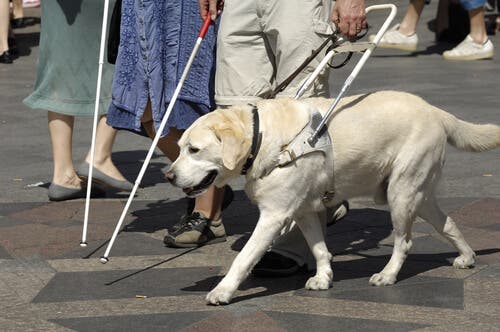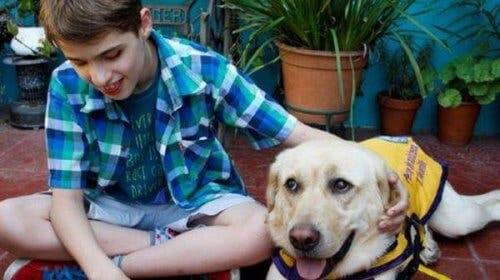What You Should Know About Guide Dogs

You’ve almost certainly seen a blind person guided by a dog on the street or in the subway. Have you wondered how guide dogs know when to cross a street or take the owner to a specific place? In this article, we’ll answer everything you’ve ever wanted to know about guide dogs.
What are guide dogs?
Also known as assistance dogs, these dogs are trained canines that direct blind or visually-impaired people on the street. They also can help them with household chores.
Guide dogs have certain privileges or rights in different countries. For example, authorities allow guide dogs to travel on public transport while they perform their duties.
However, these animals must have the capacity to identify and anticipate dangers that can jeopardize their owners’ health. This is why they undergo training!

The most common breeds of guide dogs are Labradors or Golden Retrievers, as well as German Shepherds. This is due to these breeds’ balanced temperament, intelligence, and ease of training.
One interesting thing about guide dogs is that they were originally used to guide veterans who were blinded during the First World War. Since then, however, different associations have trained animals and delivered them to people in need.
What about guide dogs’ training?
Basically, the main function of these dogs is to be eyes for people who can’t see. As a result, they must do extensive training that takes almost two years. Guide dogs are not normal pets. Instead, the training prepares them to fulfill a specific role.
Before training starts
The training process begins long before the animal is born. Trainers select purebred or pedigree puppies at breeding centers. When the puppies are two months old and no longer feed on their mother’s milk, they are vaccinated and delivered to foster homes. Then, volunteer families take care of them.

During this time, supervisors regularly visit the home to make sure the foster family is treating the animal well and giving them everything they need. The organization provides them with food and veterinary care. This care also includes sterilizing the dogs in order to avoid changes in their behavior.
Once the dogs are at an age where they’re ready to learn their tasks and start training, trainers bring them to the foundation. They live at the center with other guide dogs in training. However, their host family can ask about their progress, visit them, and eventually know who they’re living with when training ends.
How long does training take?
The training process is extensive. In fact, it takes about two years. Although it’s a difficult process, the animals don’t suffer. For example, if one dog is particularly sensitive to environmental stimuli such as noise, other dogs, or people, trainers won’t select them as an assistance dog.

Guide dogs must pass several tests. They must cross the street in a straight line, deal with doors or stairs, avoid obstacles, and identify curbs. Instructors must be patient. While trainers choose these breeds because they’re easy to train, there are always some dogs that need more time to learn than others.
What happens after training?
When a handler determines that a dog is ready to work, the next step is finding a suitable person. There are extensive waiting lists of blind people waiting for a guide dog. The handler will choose an appropriate match for the dog. What other things do handlers consider? They match up the dog based on height, weight, speed, motivation, and the types of activities required.
Although it’s true that guide dogs are helpful for blind people, the truth is that these animals don’t live a full life like other pets. Instead, their work deprives them of some stimuli. As a result, experts are working on developing robot dogs. That way, they can replace the real thing!
Finally, here’s some advice if you see a guide dog on the street. Don’t distract them, offer them food, or touch them. Only speak to them if the owner tells you it’s okay. Remember, the dog is hard at work!
You’ve almost certainly seen a blind person guided by a dog on the street or in the subway. Have you wondered how guide dogs know when to cross a street or take the owner to a specific place? In this article, we’ll answer everything you’ve ever wanted to know about guide dogs.
What are guide dogs?
Also known as assistance dogs, these dogs are trained canines that direct blind or visually-impaired people on the street. They also can help them with household chores.
Guide dogs have certain privileges or rights in different countries. For example, authorities allow guide dogs to travel on public transport while they perform their duties.
However, these animals must have the capacity to identify and anticipate dangers that can jeopardize their owners’ health. This is why they undergo training!

The most common breeds of guide dogs are Labradors or Golden Retrievers, as well as German Shepherds. This is due to these breeds’ balanced temperament, intelligence, and ease of training.
One interesting thing about guide dogs is that they were originally used to guide veterans who were blinded during the First World War. Since then, however, different associations have trained animals and delivered them to people in need.
What about guide dogs’ training?
Basically, the main function of these dogs is to be eyes for people who can’t see. As a result, they must do extensive training that takes almost two years. Guide dogs are not normal pets. Instead, the training prepares them to fulfill a specific role.
Before training starts
The training process begins long before the animal is born. Trainers select purebred or pedigree puppies at breeding centers. When the puppies are two months old and no longer feed on their mother’s milk, they are vaccinated and delivered to foster homes. Then, volunteer families take care of them.

During this time, supervisors regularly visit the home to make sure the foster family is treating the animal well and giving them everything they need. The organization provides them with food and veterinary care. This care also includes sterilizing the dogs in order to avoid changes in their behavior.
Once the dogs are at an age where they’re ready to learn their tasks and start training, trainers bring them to the foundation. They live at the center with other guide dogs in training. However, their host family can ask about their progress, visit them, and eventually know who they’re living with when training ends.
How long does training take?
The training process is extensive. In fact, it takes about two years. Although it’s a difficult process, the animals don’t suffer. For example, if one dog is particularly sensitive to environmental stimuli such as noise, other dogs, or people, trainers won’t select them as an assistance dog.

Guide dogs must pass several tests. They must cross the street in a straight line, deal with doors or stairs, avoid obstacles, and identify curbs. Instructors must be patient. While trainers choose these breeds because they’re easy to train, there are always some dogs that need more time to learn than others.
What happens after training?
When a handler determines that a dog is ready to work, the next step is finding a suitable person. There are extensive waiting lists of blind people waiting for a guide dog. The handler will choose an appropriate match for the dog. What other things do handlers consider? They match up the dog based on height, weight, speed, motivation, and the types of activities required.
Although it’s true that guide dogs are helpful for blind people, the truth is that these animals don’t live a full life like other pets. Instead, their work deprives them of some stimuli. As a result, experts are working on developing robot dogs. That way, they can replace the real thing!
Finally, here’s some advice if you see a guide dog on the street. Don’t distract them, offer them food, or touch them. Only speak to them if the owner tells you it’s okay. Remember, the dog is hard at work!
This text is provided for informational purposes only and does not replace consultation with a professional. If in doubt, consult your specialist.








